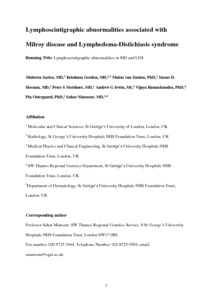Sarica, M; Gordon, K; Van Zanten, M; Heenan, SD; Mortimer, PS; Irwin, AG; Ramachandra, V; Ostergaard, P; Mansour, S
(2019)
Lymphoscintigraphic Abnormalities Associated with Milroy Disease and Lymphedema-Distichiasis Syndrome.
Lymphatic Research and Biology, 17 (6).
pp. 610-619.
ISSN 1539-6851
https://doi.org/10.1089/lrb.2019.0016
SGUL Authors: Ostergaard, Pia
![[img]](https://openaccess.sgul.ac.uk/111143/1.hassmallThumbnailVersion/Accepted%20version_2019_07_18_MD%20and%20LDS%20paper_checked.pdf)  Preview |
|
PDF
Accepted Version
Available under License ["licenses_description_publisher" not defined].
Download (1MB)
| Preview
|
Abstract
Background: Primary lymphedema is genetically heterogeneous. Two of the most common forms of primary lymphedema are Milroy disease (MD) and lymphedema-distichiasis syndrome (LDS). This study aims to look further into the pathogenesis of the two conditions by analyzing the lymphoscintigram images from affected individuals to ascertain if it is a useful diagnostic tool.
Methods and Results: The lymphoscintigrams of patients with MD and LDS were analyzed, comparing the images and transport parameters of the two genotypes against a control population. Lymphoscintigrams were available for 12 MD and 16 LDS patients (all genetically proven diagnoses). Eight of the 12 (67%) lymph scans performed on patients with MD demonstrated little or no uptake from the initial lymphatics and poor visualization of the inguinal lymph nodes. These changes were consistent with a “functional aplasia,” that is, the lymphatic vessels were present but appeared to be ineffective in absorbing the interstitial fluid into the lymphatic system. In patients with LDS the lymphoscintigraphic appearances were different. In 12 of the 16 scans (75%), the lymph scans were highly suggestive of lymphatic collector reflux. Quantification revealed a significantly reduced uptake of tracer within the inguinal lymph nodes and a higher residual activity in the feet at 2 hours in MD compared with LDS and compared with controls.
Conclusion: Lymphoscintigraphic imaging and quantification can be characteristic in specific genetic forms of primary lymphedema and may be useful as an additional tool for in-depth phenotyping, leading to a more accurate diagnosis and providing insight into the underlying mechanism of disease.
Statistics
Item downloaded times since 03 Sep 2019.
Actions (login required)
 |
Edit Item |


